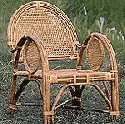The geographical area of Bangladesh – extending through the plateau and plains to the marshy land skirted by the Bay of Bengal- produce a wide variety of wood yielding plants. Botanists have identified a list of forty such wood yielding plants including bara chakma, barajamun, bauriphal, bhandras, binga, boilam, bondara, budgrat, chalta, chilauni, dhudol, eng, genedelli, geria, goda, jalpai, jam, kabashi, kandeb, kanak champa, kandra, kum, lali-kawala, lampati, lassuni, mada, mandania, murtega, orcha, palok, petakara, pitagoria, poshur, ramphal, saar, sandugaza, sultana, champa, sunder, sundry, sura, telsur and tula.
Wood from these trees are generally used for making pillars for houses, rafters, beams, carts, yokes, ploughs, planks, toys, furniture, cigar boxes, agricultural implements, railway carriage, boats, canoes and oars, walking sticks, domestic utensils, panelling and frames, staircases, flooring, partition work, splints, combs, pen holders, spear shafts, stems of hukka, bedstead legs, turnery work, cupboards, mathematical instruments and for construction work and the match industry.
The timbers used specially for carving of sculptures and decorated furniture are Krishna sirish (Albizzia amara, boivin) sirish (Albizzia lebbek, benth), east Indian walnut: chaplash (Artocarpus chaplasha – roxb), chilla (Caseria tomentosa – roxb), Bomchilla or papri (Holopetelea Intgri Olia – planch), orcha (Sonneralia), Caseolaris (Lim Engler), shisham (Black wood) (Dalbergia Latifolia), deodar (Himalayan cedar Cedrus deodara), mehogani (Toona Ciliata), Karam or haldu (Adina Cordipolia), Chittagong wood (Chukrassia tabularis), walnut (Jugulans Regia), and ebony (Diospyros Ebenum).

Some of the remarkable examples of Bengal wood carvings of the 11th-12th century A.D. are preserved in the National Museum of Bangladesh, Dhaka. Discovered at Rampal village, two wooden pillars carved with the figures of a purnakumba and the divinities; the decorated wooden lintel from Sonargang depicting the four-armed Vishnu seated in Dhyanasana, the Garuda figures in wood recovered from Raghurampur; the surasundari holding a bird on a five feet wooden pillar unearthed during the excavation of a pond in the village of Kazikaba in Vikrampur.
The wood carvings of Bengal are worked on by an artisan community called sutradharas. According to their geographical distribution the community is divided into four groups such as vardhamaniya, ashtakulasamudbhava, brahmayajniya and purvavangiya. The Purvavangiya group is distributed within the geographical area of Bangladesh.
Gallery
YOUR VIEWS
PRACTITIONERS: INDIA
Access 70,000+ practitioners in 2500+ crafts across India.
BIBLIOGRAPHY
10,000+ listings on arts, crafts, design, heritage, culture etc.
GLOSSARY
Rich and often unfamiliar vocabulary of crafts and textiles.
SHOP at India InCH
Needs to be written.





